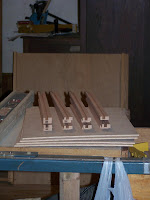
Today I made full tray table panels out of the half panels that we made yesterday. This starts by using a flush plane to shave off the glue pips and/or ridges from both sides of the half panels. Getting rid of as much of this as I can now save a good deal of wear and tear on the surface planer, which is the next step.

I switch the planer down to the slower feed speed to get the smoothest result possible. If the planer knives had had much use on them I’d have swapped them out for a fresh set as well. Then I feed all the half panels through several times, taking off just 1/64 of an inch on each pass to minimize any tearing out.
Ideally a wide drum sander would be the tool to use for this, but I don’t have one. It’s on my wish list. But, being a good steward of the resources entrusted to us, Marie won’t allow me to go out and buy all the tools I want to have on credit. That attitude may seem un-American – especially right now – but it has kept us out of the poor house when things get slow. So, we tuck away our pennies and when I have $1200 worth I’ll get a Performax sander. Until then, this beats the daylights out of doing it by hand with a scraper.

One of the more satisfying things about building these tables are these panels. I get a lot of compliments on the way they come out with no visible seams; smooth, flat and flawless. Usually. Once in a while I mess up and have to make another because the joints in one didn’t joint up the way they should. But that's rare.

The next step is to joint the seam in the middle between the two half panels. Again, the goal is to have it disappear once glued up. But, unlike the ribbon strips in the half panels, there is no “flex” involved here, clamps will not draw the joints closed because the half panels will not bend – they have to be perfect to start with.

Once the joint is perfect, I take the pair of panels into the assembly room to be glued and clamped. While the first one is setting up for an our or so I joint the rest of the pairs. When the first one comes out of the clamps I glue and clamp the second, then go sand the first one smooth and flat and fill any work holes with wood filler.
We like worm holes; they add character to a piece of furniture. But in a table top these small pits serve as places where spilled drinks or food bits may hide and fester, so I fill up all the little pits and will sand them smooth tomorrow after the filler has hardened thoroughly.

While waiting for the third full panel to set up I complete Pamela’s stopper rack by sanding all the parts, gluing the shelves and back rail to the body I assembled yesterday then pinning the joints with dowel rod. These pins go through each part into the one below and are glued in place so they are structural as well as decorative. When it was done and sanded again I shot it with three coats of lacquer, scuffing between the 2nd and 3rd coats.
Then it’s back to Ira's tables; gluing up the fourth full tray table panel, sanding and filling the third, then cleaning up the mess and getting ready to go home.
See you tomorrow!
Doug
 I spent the morning laying out and boring holes in the base plate. I applied strips of masking tape along the lines where the holes will line up so I could see the lay-out marks better. I
I spent the morning laying out and boring holes in the base plate. I applied strips of masking tape along the lines where the holes will line up so I could see the lay-out marks better. I can drill right through the tape and not hurt anything. Some of the holes will be where the upper and lower parts of the posts will attach, some are where spindles fit and others are for screws that will come up from below to attach lower cradle rails to the base plate.
can drill right through the tape and not hurt anything. Some of the holes will be where the upper and lower parts of the posts will attach, some are where spindles fit and others are for screws that will come up from below to attach lower cradle rails to the base plate. With that done I milled the post stock to size, squaring it up as I went. Then I located the centers of the ends and bored dowel holes in post ends – at least in those that get dowels, not all do.
With that done I milled the post stock to size, squaring it up as I went. Then I located the centers of the ends and bored dowel holes in post ends – at least in those that get dowels, not all do.
















































